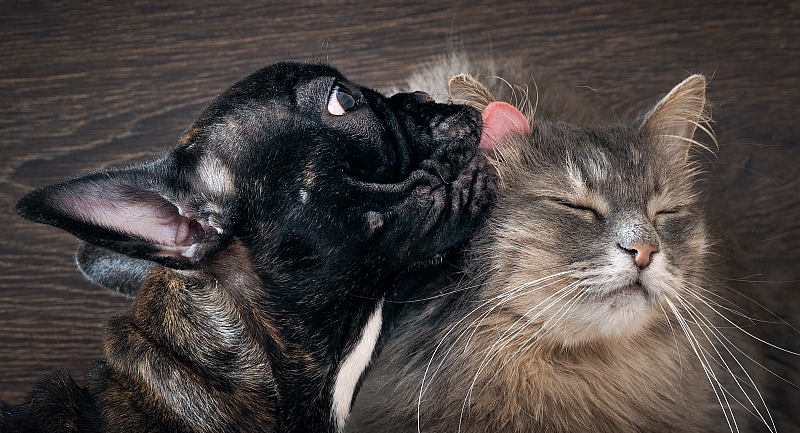Chasing cats can be a problem, especially if it is your own cat that is being chased by your pooch. Whether your dog chases your household cat(s) or the ones around the neighborhood when on walks, it is a behavior that needs to be addressed, as it can be problematic—it could injure your cat (or vice versa), or run into traffic while giving chase to a cat on the opposite side of the street.
Cartoon cats and dogs can chase one another for comedic effect, but the real world has real consequences.
Managing the Chasing Behavior & Training Your Dog
The management of the chasing instinct should preferably happen before the instinct turns into a behavior. But even if you are past that stage, the management of the behavior is the important step that needs to be taken before the chasing itself can be addressed.
Prevent Your Dog from Chasing Your Cat
In your home set up an area, such as a crate or a bathroom, where the dog can be contained away from the cat. Whenever he shows a hint of the desire to take chase, gently remove your dog from the presence of your cat, and place him in the predesignated location. Make the process as clam as possible, and allow your dog to cool down for a few minutes before releasing him from the holding area. If the behavior appears again, he should be placed back into the time-out area immediately.
To increase the chance of success, it is important to supplement the behavior management with training. This can be done by reinforcing desirable behavior, in this case ‘not chasing the cat’. You can do this be keeping a good supply of treats handy whenever your cat and dog will be sharing the same space, and reward your dog whenever he is not paying attention to the cat, or looks away from the cat and at you or something else. Gradually he’ll learn that when the cat is present and he pays her no mind that he is sure to get treats. Continue this until the chasing behavior is no longer. At this stage you can start training a bit more freedom into the environment and train your dog to move about and approach the cat in a calm manner, until such time that they can calmly coexist.
Prevent Your Dog from Chasing Outside the Home
Not everyone has a cat at home with which to practice the not-chasing behavior, and often the problem is with dogs which don’t have any exposure to cats, and will chase them (and other animals) while on walks or on a hike. This can present many safety issues, so it is important to address the behavior, which is really just an inborn trait of most dogs.
Begin by training your dog to pay attention to you at all times, especially on command. You can do so by using positive reinforcement in the form of treats. In your home (or back yard) use treats and verbal cues (e.g. ‘good girl!’) to praise your dog whenever she displays the desired behavior of keeping his attention on you by following you and making eye contact. You can do so by going about your activities and praise your dog and give her treats whenever she is by your site, and be especially emphatic with your praise and generous with the treats when she makes eye contact. By doing this exercise your dog will develop the understanding that if she pays close attention to you, stays by your side, and makes eye contact, good things will happen.
Once this understanding has been established, you can start introducing a command signal like a whistle to get your dog’s attention. Whenever she responds positively to the signal she gets a treat and praise. Repeating this exercise will add a second element into the process whereby you can get your dog’s attention by using the signal. This signal can be used later to get her attention if there is a chance of a chase taking place, and by doing so putting her attention on you as opposed to the subject of the impending chase.
When the signal has been well learned, then you can start introducing some distractions into the process in the form of toys, and other people within the environment. Gradually, as you become confident that your dog is not easily swayed by distractions, you can take her for a walk in an area where there is the potential of running into cats or other small animals. If she shows an interest in chasing, you can utilize the signal to get her attention, and then praise and give her a treat if she responds positively, and does not display the desire to chase. Eventually, with this process, you can suppress the desire to chase.
This could be a lengthy process, but it is worth the effort in order to be able to have enjoyable outings, and prevent potential injuries to your dog and other animals.

